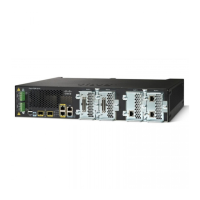1-3
Catalyst 3550 Multilayer Switch Software Configuration Guide
78-11194-09
Chapter 1 Overview
Features
• Directed unicast requests to a DNS server for identifying a switch through its IP address and its
corresponding host name and to a TFTP server for administering software upgrades from a TFTP
server
• Address Resolution Protocol (ARP) for identifying a switch through its IP address and its
corresponding Media Access Control (MAC) address
• Unicast MAC address filtering to drop packets with specific source or destination MAC addresses
• Cisco Discovery Protocol (CDP) versions 1 and 2 for network topology discovery and mapping
between the switch and other Cisco devices on the network
• Network Time Protocol (NTP) for providing a consistent timestamp to all switches from an external
source
• Cisco IOS File System (IFS) for providing a single interface to all file systems that the switch uses
• In-band management access through CMS
• In-band management access through up to 16 simultaneous Telnet connections for multiple
command-line interface (CLI)-based sessions over the network
• In-band management access for up to five simultaneous, encrypted Secure Shell (SSH) connections
for multiple CLI-based sessions over the network
• In-band management access through Simple Network Management Protocol (SNMP) versions 1,
2c, and 3 get and set requests
• Out-of-band management access through the switch console port to a directly attached terminal or
to a remote terminal through a serial connection or a modem
Note For additional descriptions of the management interfaces, see the “Management Options” section on
page 1-7.
Redundancy
• Hot Standby Router Protocol (HSRP) for command switch and Layer 3 router redundancy
• UniDirectional Link Detection (UDLD) and aggressive UDLD on all Ethernet ports for detecting
and disabling unidirectional links on fiber-optic interfaces caused by incorrect fiber-optic wiring or
port faults
• IEEE 802.1D Spanning Tree Protocol (STP) for redundant backbone connections and loop-free
networks. STP has these features:
–
Per-VLAN spanning-tree plus (PVST+) for load balancing across VLANs
–
Rapid PVST+ for load balancing across VLANs
–
UplinkFast, cross-stack UplinkFast, and BackboneFast for fast convergence after a
spanning-tree topology change and for achieving load balancing between redundant uplinks,
including Gigabit uplinks and cross-stack Gigabit uplinks
• IEEE 802.1S Multiple Spanning Tree Protocol (MSTP) for grouping VLANs into a spanning-tree
instance, and providing for multiple forwarding paths for data traffic and load balancing
• IEEE 802.1W Rapid Spanning Tree Protocol (RSTP) for rapid convergence of the spanning tree by
immediately transitioning root and designated ports to the forwarding state
• Optional spanning-tree features available in PVST+, rapid-PVST+, and MSTP mode:
–
Port Fast for eliminating the forwarding delay by enabling a port to immediately transition from
the blocking state to the forwarding state

